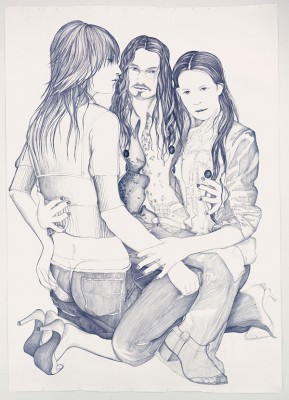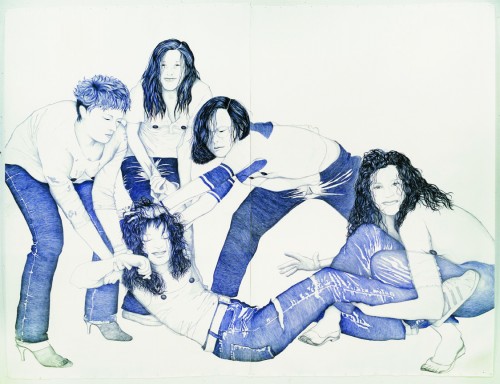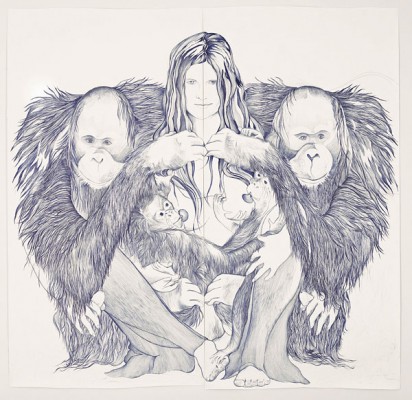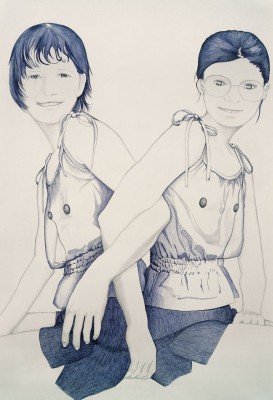PUSSY – BEAVER – CUNT. This was the first I remember of Marlene McCarty’s art– words, shocking ones at that, the sort of language hurled at women on the street, the words used to take power and show who has it. They were on canvas “painted,” so to speak, though they’d actually been ironed on with heat-transfer letters just like you’d wear on a t-shirt. These weren’t Marlene’s first words I’d seen though. Those were “Kissing Doesn’t Kill,” and I had no idea she’d had anything to do with them. They were produced by Gran Fury, ACT UP’s innovative, anonymous and in-your-face advertising and propaganda arm. No, “Pussy – Beaver – Cunt” was bracing, shocking – and on the bright white walls of an art gallery in Soho in 1990. They now reside in the Brooklyn Museum.

1 of 3 panels in a cycle, "Planned Assassination" is based on Clara Jane Schwartz's planned killing of her father. Marlene McCarty, Graphite and ballpoint on paper
Marlene’s work rides a seam of violence. A trained graphic designer, she also taps the power of design, producing something that can seduce combined with the dark, ambiguous and unsettling. And, she refuses to make that dark and unsettling easy or comfortable. In her hands the hard-to-look-at propels you to stare.
One Gran Fury member, the filmmaker Tom Kalin, wrote that her work had the same the same power, the terrorism of the imagination, of another Marlene – Marlene Olive who killed her mother in 1975. With that statement, Marlene McCarty started investigating the other Marlene’s story and that slippery moment where families float free from their moorings.

Unhinged from her family, Marlene Olive along with her boyfriend killed her mother and then her boyfriend killed her father. Marlene McCarty, "Marlene Olive," ballpoint pen and graphite on paper.
McCarty started drawing first Marlene Olive then other girls who were parricidal. She made them full-length to avoid dimunizing them, the Barbie-ization, as she puts it, of these girls. Working with Bic pens and pencils, the work is intense, monumental and intimate. The marks on paper are small and labor intensive. It takes months to finish just one, but the technique is like those teenaged doodles on jeans and sneakers and notebooks only writ large, as if crossed with history painting. The drawings are also sexy, and that sexiness is disturbing. In the drawings elements are unfinished; fashion magazines are brought into these killers’ worlds. The drawings virtually vibrate with the tension, like an off register print. Here the tension pulls between the technique and the facts, between the eroticism and the girls and their stories. You want to stare; the girl is sexy. You know her story and you don’t want to look. The truth is too awful, and the work is designed to make you uncomfortable. Pussy, beaver, cunt indeed.

One panel of a 4-part mural series, this depicts Shanda Sharer and Melinda Loveless, Toni Lawrence, Hope Rippey and Laurie Tackett. Sharer was 12, and killed by the four other girls, an act of jealousy and revenge instigated by Melinda Loveless because of the attention her lover, another teen girl, paid to Shanda. The events are frightening, chilling, and it's as if the drawings' being unfinished and the hidden details revealed hint at what's concealed and the horror of the events.
As Marlene puts it, she was interested in “normal” families where somehow the abnormal happened, where, as Marlene puts it, “everyday domestic pressures catalyzed into unbounded attempts at self liberation.” While the work is hardly biographical, there is still the slippage in the two Marlenes, in the very names.

An infant orang-utan adopts a surrogate mother in a Ph. D student, literally setting off an Oedipal series of events, dividing husband and wife, until the mother had to file her dissertation, leaving the jungle. Then the "father" / husband expelled the young orang-utan. Marlene McCarty, "Group 3 (Tanjung Putting, Borneo. 1971)."
Next with the issue of families, Marlene moved onto humans and the great apes, of which we are part, and began drawing various experiments of “humanizing” apes. “Lucy and Janice” is taken from the true story of Lucy Temerlin a chimpanzee adopted by a human family as their child. Lucy slept with her parents and learned sign language. She wasn’t like a family member; she was a family member. Until 13 years later they decided to send her back to the wild, to Africa, a continent Lucy had never seen. An anthropology grad student Janice Carter took her back and as McCarty writes, “She planned to stay with Lucy for three weeks. Lucy was scared, depressed and kept signing that she wanted to go home. She kept asking for human food. Lucy lost weight and hair. Janice couldn’t leave her and began to communicate with Lucy using pant hoot signals. Unexpectedly Janice learned to “speak” chimp. Years passed and Lucy finally began to make social progress bonding with “natural” chimps and supporting herself as a hunter gatherer in the forest. As natural redemption appeared to be on the horizon Lucy was killed by poachers. Janice had lived with Lucy for 10 years in the jungle.”
The way people and roles slip is at the heart of Marlene’s work. It starts with where the abuse hurled at women slips free from the intention and is reappropriated and moves on through how culture is created to the places where identity is made and then falls away from its intentions – whether family, sexuality, the very nature of “man” himself.
Marlene McCarty, "Lucy and Janice. 1977-1988. The Gambia." Ballpoint pen and graphite and plaka on paper




By evolution, humans are humanized animals. If you consider humanization of animals to be unethical, you are implying that the existence of humans is unethical. Are you advocating that all humans shold be killed for ethical reasons? If not, then stop claiming that humanization of animals is unethical! See Pure science Wiki.